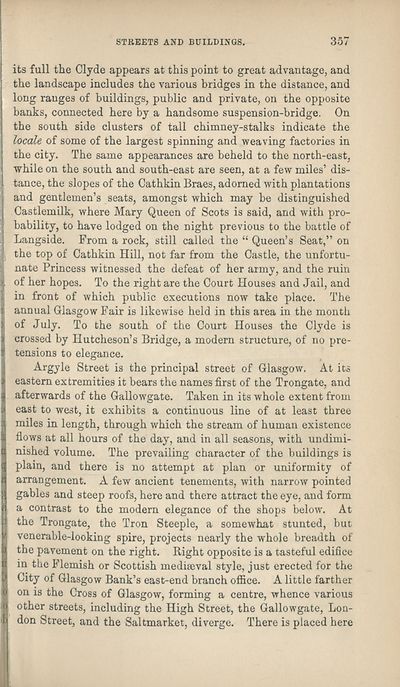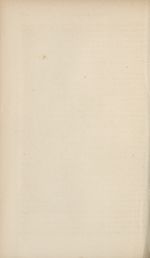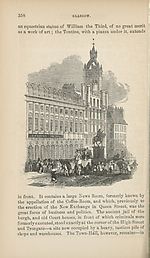Download files
Complete book:
Individual page:
Thumbnail gallery: Grid view | List view

STREETS AND BUILDINGS.
357
its full the Clyde appears at this point to great advantage, and
the landscape includes the various bridges in the distance, and
long ranges of buildings, public and private, on the opposite
banks, connected here by a handsome suspension-bridge. On
the south side clusters of tall chimney-stalks indicate the
locale of some of the largest spinning and weaving factories in
the city. The same appearances are beheld to the north-east,
while on the south and south-east are seen, at a few miles’ dis¬
tance, the slopes of the Cathkin Braes, adorned with plantations
and gentlemen’s seats, amongst which may be distinguished
Castlemilk, where Mary Queen of Scots is said, and with pro¬
bability, to have lodged on the night previous to the battle of
Langside. From a rock, still called the “ Queen’s Seat,” on
the top of Cathkin Hill, not far from the Castle, the unfortu¬
nate Princess witnessed the defeat of her army, and the ruin
of her hopes. To the right are the Court Houses and Jail, and
in front of which public executions now take place. The
annual Glasgow Fair is likewise held in this area in the month
of July. To the south of the Court Houses the Clyde is
crossed by Hutcheson’s Bridge, a modern structure, of no pre¬
tensions to elegance.
Argyle Street is the principal street of Glasgow. At its
eastern extremities it bears the names first of the Trongate, and
afterwards of the Gallowgate. Taken in its whole extent from
east to west, it exhibits a continuous line of at least three
miles in length, through which the stream of human existence
flows at all hours of the day, and in all seasons, with undimi¬
nished volume. The prevailing character of the buildings is
plain, and there is no attempt at plan or uniformity of
arrangement. A few ancient tenements, with narrow pointed
gables and steep roofs, here and there attract the eye, and form
a contrast to the modern elegance of the shops below. At
the Trongate, the Tron Steeple, a somewhat stunted, but
venerable-looking spire, projects nearly the whole breadth of
the pavement on the right. Right opposite is a tasteful edifice
in the Flemish or Scottish mediaeval style, just erected for the
City of Glasgow Bank’s east-end branch office. A little farther
on is the Cross of Glasgow, forming a centre, whence various
other streets, including the High Street, the Gallowgate, Lon¬
don Street, and the Saltmarket, diverge. There is placed here
357
its full the Clyde appears at this point to great advantage, and
the landscape includes the various bridges in the distance, and
long ranges of buildings, public and private, on the opposite
banks, connected here by a handsome suspension-bridge. On
the south side clusters of tall chimney-stalks indicate the
locale of some of the largest spinning and weaving factories in
the city. The same appearances are beheld to the north-east,
while on the south and south-east are seen, at a few miles’ dis¬
tance, the slopes of the Cathkin Braes, adorned with plantations
and gentlemen’s seats, amongst which may be distinguished
Castlemilk, where Mary Queen of Scots is said, and with pro¬
bability, to have lodged on the night previous to the battle of
Langside. From a rock, still called the “ Queen’s Seat,” on
the top of Cathkin Hill, not far from the Castle, the unfortu¬
nate Princess witnessed the defeat of her army, and the ruin
of her hopes. To the right are the Court Houses and Jail, and
in front of which public executions now take place. The
annual Glasgow Fair is likewise held in this area in the month
of July. To the south of the Court Houses the Clyde is
crossed by Hutcheson’s Bridge, a modern structure, of no pre¬
tensions to elegance.
Argyle Street is the principal street of Glasgow. At its
eastern extremities it bears the names first of the Trongate, and
afterwards of the Gallowgate. Taken in its whole extent from
east to west, it exhibits a continuous line of at least three
miles in length, through which the stream of human existence
flows at all hours of the day, and in all seasons, with undimi¬
nished volume. The prevailing character of the buildings is
plain, and there is no attempt at plan or uniformity of
arrangement. A few ancient tenements, with narrow pointed
gables and steep roofs, here and there attract the eye, and form
a contrast to the modern elegance of the shops below. At
the Trongate, the Tron Steeple, a somewhat stunted, but
venerable-looking spire, projects nearly the whole breadth of
the pavement on the right. Right opposite is a tasteful edifice
in the Flemish or Scottish mediaeval style, just erected for the
City of Glasgow Bank’s east-end branch office. A little farther
on is the Cross of Glasgow, forming a centre, whence various
other streets, including the High Street, the Gallowgate, Lon¬
don Street, and the Saltmarket, diverge. There is placed here
Set display mode to:
![]() Universal Viewer |
Universal Viewer | ![]() Mirador |
Large image | Transcription
Mirador |
Large image | Transcription
| Antiquarian books of Scotland > Scotland/Scots > Black's picturesque tourist of Scotland > (463) |
|---|
| Permanent URL | https://digital.nls.uk/130033746 |
|---|
| Description | Thousands of printed books from the Antiquarian Books of Scotland collection which dates from 1641 to the 1980s. The collection consists of 14,800 books which were published in Scotland or have a Scottish connection, e.g. through the author, printer or owner. Subjects covered include sport, education, diseases, adventure, occupations, Jacobites, politics and religion. Among the 29 languages represented are English, Gaelic, Italian, French, Russian and Swedish. |
|---|

